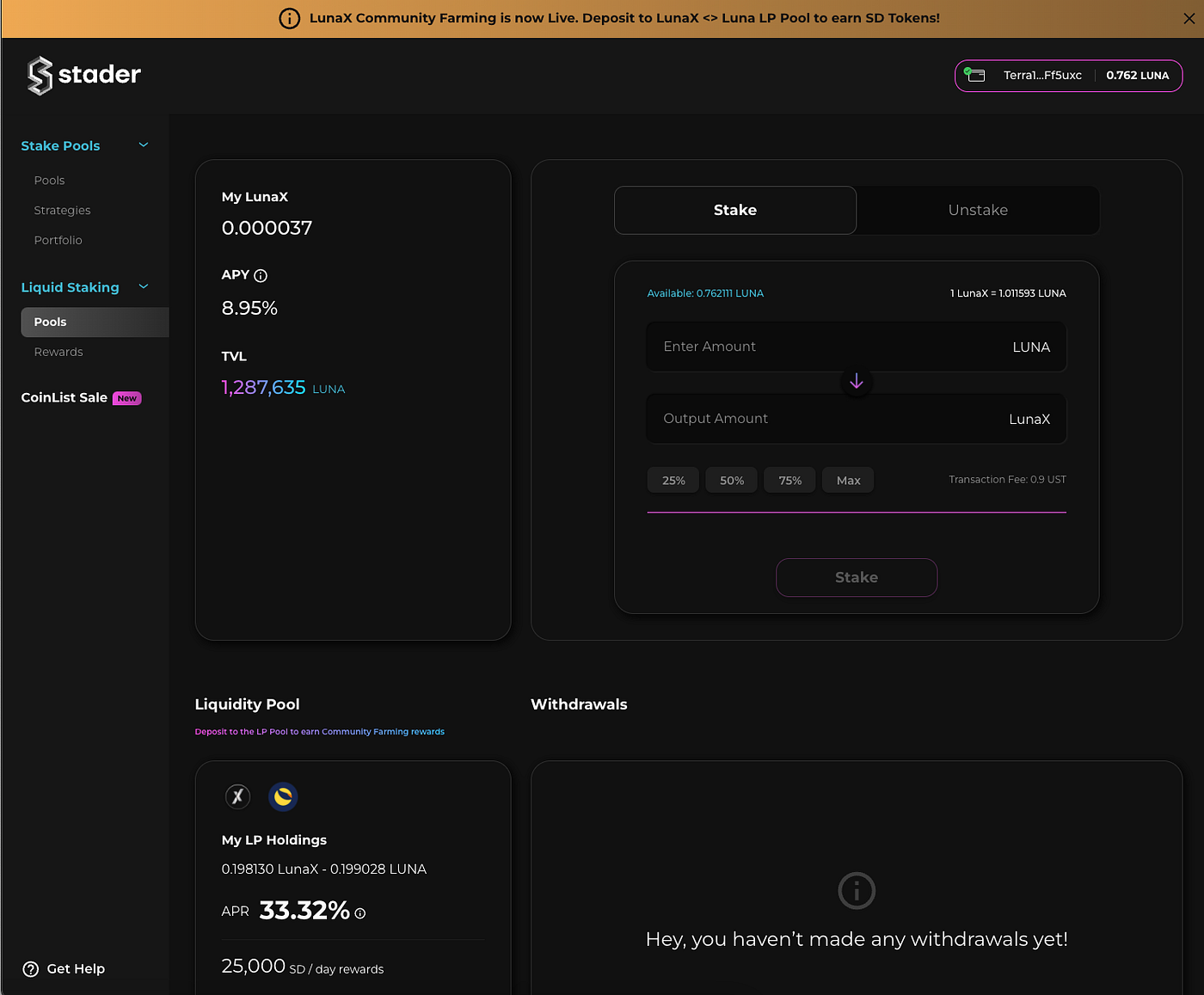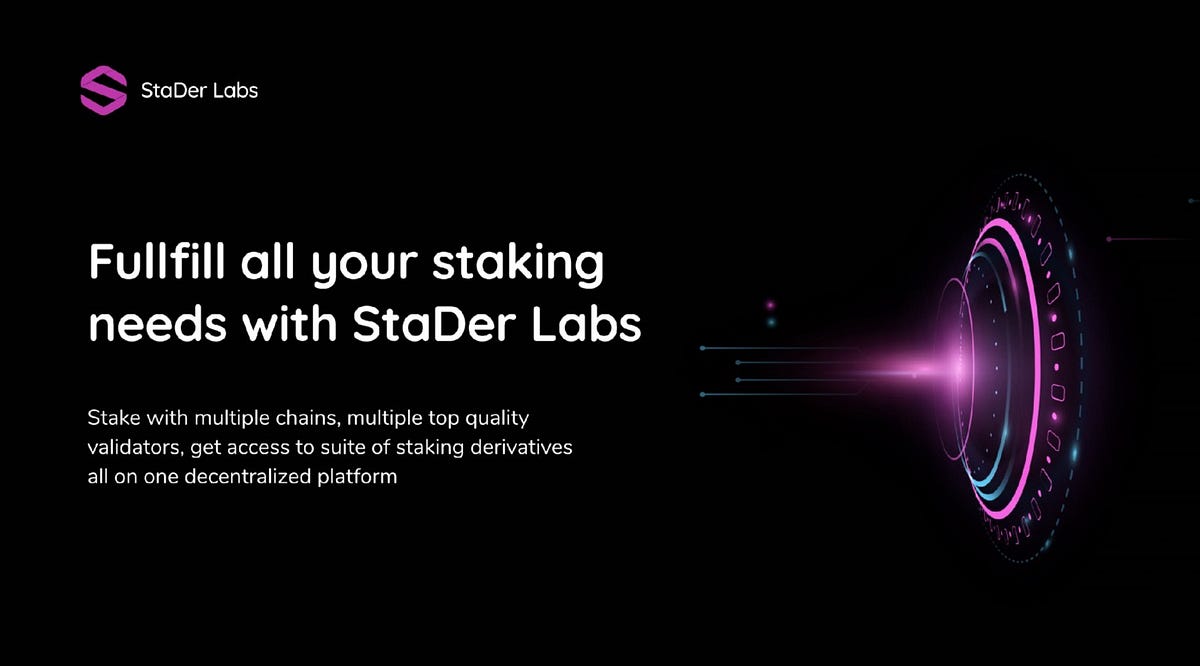
It is interesting to see how FinTech has evolved in recent times, and every moment, new FinTech solutions get rolled out to make transactions much easier, and to provide users with more flexible and safe options when performing transactions.
While there may be so many FinTech startups out there, one company that stands out among so many is Stader.
Stader was created to make it easier for users of the blockchain and Proof-of-Stake (PoS) networks to have their assets staked in a safe and convenient manner via its ever growing platform. Stader intends to do it by creating a platform that integrates major staking middleware architecture to aid transactions and operations on Proof-of-Stake (PoS) networks, and the protocol can be used at different stages of customer interactions and with different systems including major FinTech players in the industry. It may interest you to know that Staders smart contracts are designed to help third parties to integrate the Stader solution into different FinTech-based systems for better leverage and good results.

Furthermore, the Stader team is working hard and smart to build native smart contracts that will function across different blockchains including Ethereum, Terra, Hedera, Fantom, Polygon, and Solana among others. They are creating an effective and efficient economic ecosystem that will facilitate the growth and development of different FinTech and decentralised finance (DeFi) solutions like liquid staking, rewards, gaming, launchpads, etc. These solutions will not only make DeFi operations better, but it will also contribute to the mainstream adoption of blockchain technology and related innovations.
Stader intends to be here for a very long term, and it will continue to provide solutions to third parties looking to create different applications for staking and other purposes; these solutions will be developed with the infrastructure that Stader has made available.
What is Plain and Liquid Staking?

Before explaining what Plain and Liquid staking are, it is imperative that you know what staking is, and that is assuming that you do not already know what it is. Staking in cryptocurrency refers to an activity that involves the verification of crypto transactions by holding a couple of cryptocurrencies, as a way to support the token’s related blockchain network. Crypto staking is a passive way for token stakers to earn income, based on their holdings.
It is worthy of note that the staking economy has experienced nothing but exponential increase since DeFis started gaining traction within the crypto community, and interestingly, more than $240 billion worth of staking exists. It may interest you to know that in 2021, the Proof-of-Stake market capitalization experienced an increase that was fifteen times more than it was, and that was between January of 2021 to October of the same year; the staking economy grew from $21 billion to $325 billion, and the growth has played a major role in increasing the market cap of PoS-based transactions, which is one of the major players in the general cryptocurrency market capitalization.
When staking is mentioned, there are two ways that staking can happen:
● Plain Staking
Basically, plain staking refers to a staking process that involves the locking up of staked assets over a period of time. It’s just as plain as it sounds, with barely any side attractions.
● Liquid Staking
In order for users to actively participate in DeFi, there are different ways that DeFi systems incentivize and reward their users, and liquid staking is one of the ways. In liquid staking, the user is given a liquid token for the assets that they stake, and those tokens can be used to earn passively, among other uses.
LunaX and Community Farming

Stader introduced a token for liquid staking called LunaX, and it gives users the ability to instantly unlock their staked Luna, and it also paves the way for different possibilities when using various DeFi infrastructures.
Some benefits that LunaX users have access to include:
● Stablecoins can be converted to Luna, and then used for auto-compounding.
● Users will enjoy airdrops, and it will be a function of random snapshots taken weekly.
● Liquidity is instant whenever the user wants.
● There are diverse opportunities for the yields to get enhanced.
There are different major applications of LunaX, as it presents holders of the Luna tokens with different opportunities. When community farming takes place, there will be LunaX liquidity pools, and when liquidity is provided by a user, the user will have access to swap fees, SD tokens, and possible incentives from decentralised exchanges. Future applications of LunaX include the following:
● Simple Leverage
Users will be able to borrow different assets, including UST, when LunaX is leveraged.
● Leveraged Staking
Air drops and staking rewards will be earned by the user if they borrow Luna after leveraging LunaX. It may interest you to know that the rewards are proportional to the frequency of LunaX leverage.
● Futures and Options
Users will be able to build multiple futures and options, and they will be done on LunaX. Furthermore, air drops and staking rewards can be earned when Luna is shorting and speculations made about its price.
● Anchor Fusion
There is the possibility of an Anchor integration in the near future. However, it is all dependent on governance voting. With the integration, LunaX can be converted to bLunaX, and that invariably means that the rewards will get separated into different contracts, while the bLunaX will function as a collateral to facilitate operations on Anchor.
● Compatibility with Different Chains
By default, LunaX’s accretive nature makes it compatible with multiple chains.

There were two rounds of community farming; the first one was the Plain Staking Community Farming, and the second one involved Liquid Staking. With community farming, users were able to perform stakes with the liquid stakning pool of Stader, and then have LunaX minted, all at the exchange rate available on Stader. In order for users to have SD tokens farmed, it is imperative that liquidity is provided for the LunaX to Luna liquidity pool, on Terraswap. There are indications that in the near future there will be more pools available on other decentralised exchanges (DEXs).
Liquidity pool providers will farm the SD tokens everyday for the first two months after the community farming has begun, and then the SD tokens that have been farmed will get vested through a period of six months, and interestingly, liquidity providers do not need to pay withdrawal fees.
What are Stader’s Future Plans?

Stader was launched in the third quarter of 2021, and went live on the Terra Testnet when it was launched, and the team went back to the drawing board to facilitate their plans and bring their strategies to fruition. In the second quarter of 2021, Terra was the platform where Stader’s stake pools were launched, and the LunaX liquid staking was also launched on the same platform within the fourth quarter.
In the first quarter of 2022, Stader intends to launch Solana, as well as another chain, and they intend to go into partnerships with exchanges and custodians. The second quarter of 2022 will see Stader spread their tentacles to include three or more additional chains, and they also intend to launch staking for institutions.
According to their product roadmap, Staking APi for exchanges will be available in the third quarter of 2022, and they will extend the protocol to 3 or more chains.
How does the Stader Product Work?

Stader has taken the bull by the horns, by identifying the major problems that are experienced by the three major stakeholders of the Proof-of-Stake networks, namely the Validators, PoS Networks, and Delegators.
Stader brings a modular approach at tackling the challenges experienced by the stakeholders, and at the core of the solutions are major smart contracts, and they include:
● Validator Contract
● Delegator Contract
● Strategies Contract
● Pools Contract
By adopting a modular infrastructure, Stader is positive that it will pave the way for third parties to integrate any of the smart contracts into their systems, and thus create more use cases for staking.
The flexible nature of Stader makes the architecture relevant long after staking has evolved in the coming years.

Stader uses the various smart contracts to separate the rewards from the base capital, and thus the isolation of the base capital mitigates risks that could come from interacting with other systems. One of the attributes of the Stader product is the safety it brings to staking, and so users do not need to worry about what may happen to their base capital, as the isolation will keep it safe.
As Stader continues to grow and get the market share on different chains, they intend to roll out more features that will make it possible for more protocols and products to get created and used.

Considering that the world of staking is growing rapidly within and outside the crypto community, Stader is positioning itself strategically to take DeFi, FinTech and blockchain adoption to great heights, through its amazing staking products and features that seek to make staking easier and seamless for everyone, even for third parties looking to create staking protocols with the Stader infrastructure.
Useful links:
Website
Litepaper
LunaX Litepaper
Staking dApp
Telegram ANN
Telegram Chat
Medium
Discord














